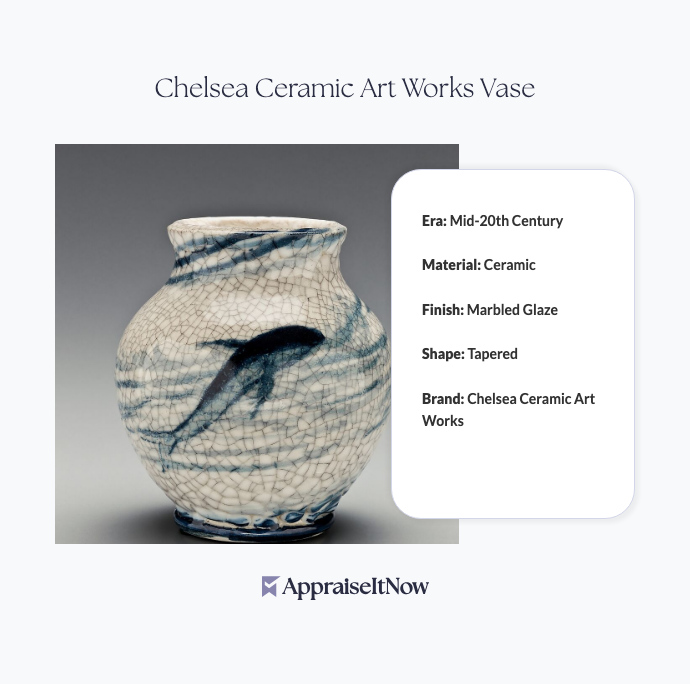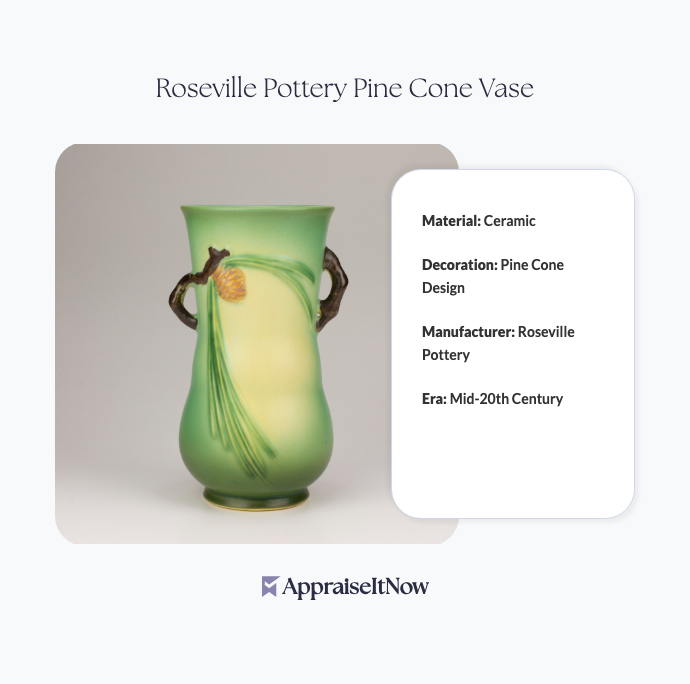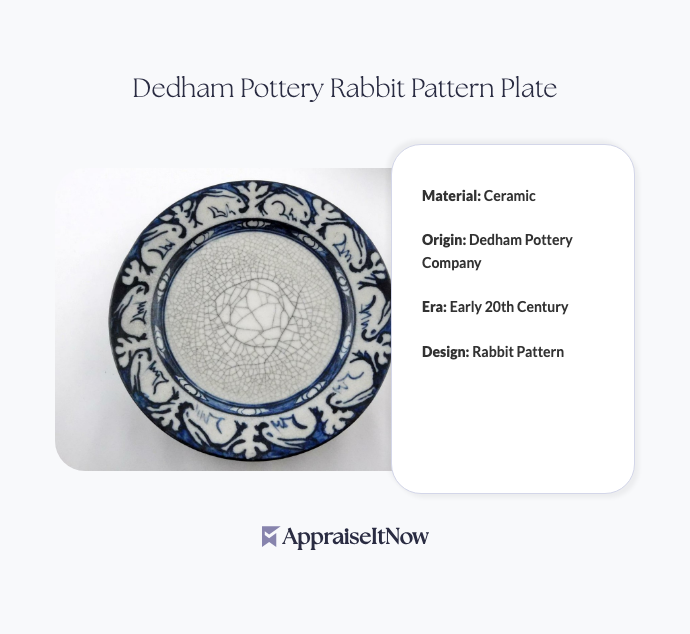<h1>How to Get Your Flow Blue Staffordshire Platter Appraised</h1>
<p>If you've inherited a Flow Blue Staffordshire platter or discovered one at an estate sale, you're holding a piece of 19th-century English ceramic history. These distinctive blue-and-white collectibles have been commanding strong interest among <a href="/types/antiques">antique ceramics collectors</a>, with values ranging from <strong>$500 to $1,200</strong> depending on condition, pattern rarity, and provenance. Understanding the appraisal process helps you make informed decisions about authentication, insurance, or sale.</p>
<h2>What Makes Flow Blue Staffordshire Platters Valuable</h2>
<p>Flow Blue Staffordshire platters earned their collectibility through a unique combination of artistic technique and British craftsmanship. Produced primarily during the 1800s, these serving pieces feature distinctive blue-and-white patterns created through a specialized glaze technique that allowed cobalt oxide to "flow" across the ceramic surface during firing. This process, while challenging to master, resulted in intricate designs that remain visually striking more than a century later.</p>
<p>The manufacturing process itself adds value. Potter marks, maker signatures, and specific pattern names documented by collectors help establish authenticity and desirability. Is flow blue worth anything? Absolutely—the limited production run combined with the technical difficulty of the glazing process means well-preserved examples maintain consistent market demand among tableware collectors and museums alike.</p>
<div class="callout tip"><p><strong>Collector's Insight</strong></p>
<p>Flow Blue platters with documented maker's marks from renowned Staffordshire potters command premiums of 25-40% over unmarked examples of similar condition.</p></div>
<h2>Key Factors Affecting Your Platter's Appraisal Value</h2>
<p>When a professional appraiser evaluates your Flow Blue Staffordshire platter, they examine specific characteristics that determine its position within the $500-$1,200 market range. Condition stands as the primary driver—original glaze integrity, absence of chips or cracks, and pattern clarity directly correlate to higher valuations.</p>
<p>The pattern itself matters significantly. How to identify flow blue pieces involves recognizing the maker's specific design vocabulary. Rarer patterns documented in collector references command higher values than common designs. Similarly, the size of your platter affects worth; larger serving pieces typically value higher than smaller bread plates or dessert platters due to increased utility and space requirements for collectors.</p>
<p>Provenance—the documented history of ownership—can substantially impact appraisal results. A platter with clear ownership records, exhibition history, or published documentation in collector guides achieves premium valuations. Conversely, platters with unknown origins require more conservative estimates despite identical condition.</p>
<table class='appraisal-table'>
<thead>
<tr>
<th>Value Factor</th>
<th>Impact</th>
<th>Details</th>
</tr>
</thead>
<tbody>
<tr>
<td>Maker identification</td>
<td>+20-35%</td>
<td>Documented Staffordshire potter stamps</td>
</tr>
<tr>
<td>Pattern rarity</td>
<td>+15-30%</td>
<td>Uncommon designs vs. mass-produced patterns</td>
</tr>
<tr>
<td>Condition grade</td>
<td>±40-50%</td>
<td>Affects entire valuation range</td>
</tr>
<tr>
<td>Size</td>
<td>±10-20%</td>
<td>Larger pieces generally valued higher</td>
</tr>
<tr>
<td>Provenance</td>
<td>+10-25%</td>
<td>Documented ownership history</td>
</tr>
</tbody>
</table>
<h2>Understanding Flow Blue Authenticity and Age</h2>
<p>How old is flow blue china? The technique gained popularity starting around 1800 and remained standard production through the Victorian era, with peak popularity occurring between 1840-1900. This 100-year production window means your platter's age alone doesn't determine its value—rather, its specific period within this range combined with maker identity establishes historical significance.</p>
<p>Can you eat off flow blue china today? Technically yes, though most collectors treat these pieces as decorative investments rather than functional dinnerware. Lead content in period glazes varies by manufacturer and production year, making some examples unsuitable for food service. Professional appraisers test for lead when requested, providing documentation of food-safety considerations. Whether you're evaluating your family's china cabinet or wondering if your dishes are worth money, professional assessment clarifies both value and safe handling practices.</p>
<p>Determining authenticity requires examining manufacturing details that distinguish genuine Flow Blue from later reproductions. Appraising fine porcelain and ceramics involves knowledge of period glazing characteristics, body composition, and decoration techniques that trained specialists develop through years of hands-on evaluation. Early Flow Blue features specific glaze flow patterns and pottery body characteristics that reproduction pieces struggle to replicate convincingly.</p>
<div class="callout note"><p><strong>Authenticity Consideration</strong></p>
<p>Modern reproductions exist, but careful examination of glaze depth, pattern consistency, and firing characteristics reveals manufacturing era. Professional <a href="/blog/appraisals-for-fine-porcelain-and-ceramics-valuing-delicate-artistry">ceramics appraisals</a> employ comparative analysis and documentation to confirm authenticity with certainty.</p></div>
<h2>How to Prepare Your Platter for Professional Appraisal</h2>
<p>Before submitting your Flow Blue Staffordshire platter for valuation, gather available documentation that supports its history. Photographs taken under natural light showing the top, bottom, underside maker's marks, and any pattern details provide appraisers with initial information. Documenting the platter's dimensions using a ruler and noting any visible imperfections—hairline cracks, glaze crazing, or color variations—helps professional evaluators conduct thorough assessments.</p>
<p>Handle your platter carefully during preparation phases. Avoid aggressive cleaning that might remove surface patina or damage glaze characteristics that appraisers use for authentication and dating. If previous ownership records exist—auction catalogs, insurance documents, gallery tags, or family documentation—compile these materials for appraiser review. Clear provenance accelerates the valuation process and often supports higher valuations.</p>
<p>Clean your platter gently using lukewarm water and soft cloths only. Harsh commercial cleaners or abrasive materials risk damaging the specialized glaze that defines Flow Blue's distinctive appearance. Your goal is presenting the platter in its authentic condition without overly aggressive restoration that might actually reduce value.</p>
<h2>The Professional Appraisal Process</h2>
<p>Selecting a qualified appraiser experienced with <a href="/blog/unraveling-the-mysteries-of-antique-appraisals-a-guide-for-collectors">antique ceramics and decorative arts</a> ensures accurate valuation. Look for professionals holding credentials from recognized organizations such as AAA (American Association of Appraisers), ISA (International Society of Appraisers), or ASA (American Society of Appraisers). These certifications indicate comprehensive training in USPAP (Uniform Standards of Professional Appraisal Practice) compliance and specialized knowledge in ceramics valuation.</p>
<p>During the appraisal appointment, the specialist examines your platter's maker's mark, pattern name, glaze characteristics, and condition grade. They document size measurements, photograph all surfaces, and reference comparable sales from auction houses, dealer catalogs, and private sales to establish current market value. The resulting report provides detailed condition assessment, authentication confirmation, and fair market value—critical documentation for insurance coverage or sale purposes.</p>
<p>Professional appraisals typically include high-resolution photographs, detailed written descriptions, condition grading using standardized scales, and comparative market analysis supporting the final value estimate. This documentation satisfies insurance companies, financial institutions, and potential buyers or auction houses evaluating your piece.</p>
<h2>Valuation Context: Market Trends for Flow Blue Staffordshire</h2>
<p>The Flow Blue collectibles market has demonstrated steady appreciation over recent decades, driven by growing interest in Victorian-era tableware and English ceramics among interior designers and heritage preservationists. Market demand for well-documented Flow Blue pieces with clear Staffordshire pottery attributions remains robust, supporting valuations in the established $500-$1,200 range.</p>
<p>Recent trends show particular appreciation for larger serving pieces compared to smaller individual plates. Dinner plates and serving platters command premium prices relative to cup-and-saucer sets or soup bowls of equivalent age and pattern rarity. This positional advantage helps Flow Blue Staffordshire platters—your platter's likely size category—achieve values toward the upper end of the market range when condition and rarity support premium positioning.</p>
<p>Understanding how your platter's specific characteristics fit within broader tableware appraisal markets helps set realistic value expectations. Similar to evaluating <a href="/blog/understanding-the-value-of-antique-furniture-examining-quality-and-rarity">antique furniture appraisals</a> based on maker reputation and construction quality, ceramic valuations depend heavily on verified potter identification and pattern documentation within the collector community.</p>
<h2>Where to Sell Your Flow Blue Staffordshire Platter</h2>
<p>If you decide to monetize your appraisal, several sales channels serve different seller needs. Specialized ceramic auction houses like Sotheby's or Christie's reach high-end collectors and museums, though they typically require minimum estimates and charge commission percentages. Regional auctioneers with antiques departments provide more accessible entry points for platters valued in the $500-$1,200 range, often charging lower commission rates.</p>
<p>Online marketplaces including Ebay, Etsy, and specialized sites like Replacements.com connect directly to collectors seeking specific Flow Blue patterns. Direct sale to antique dealers provides immediate payment in exchange for lower prices, as dealers require profit margins. Each channel has distinct advantages—auction houses validate market value through competitive bidding, while direct sales offer faster transactions with less uncertainty about final proceeds.</p>
<p>Professional appraisal documentation strengthens your position across all sales channels by providing third-party verification of authenticity, condition, and value. Buyers consistently pay premiums for pieces accompanied by certified appraisals from recognized specialists.</p>
<div class="callout tip"><p><strong>Selling Strategy</strong></p>
<p>Condition grading and pattern identification from professional appraisals significantly accelerate sales and support higher asking prices compared to descriptions lacking expert documentation.</p></div>
<h2>Insurance and Estate Planning Considerations</h2>
<p>If your Flow Blue Staffordshire platter represents part of a larger estate or valuable collection, certified appraisal documentation becomes essential for insurance purposes. Standard homeowners policies provide limited coverage for collectible ceramics—typically capping personal property claims at $2,500-$5,000 regardless of actual value. Scheduling your platter specifically on an insurance rider requires appraisal documentation establishing fair market value for insurance purposes.</p>
<p>For estate planning and tax compliance, valuations determine inheritance tax liability and distribution decisions. Professional appraisals provide the documented basis for estate administrators and tax professionals making these calculations. Equitable division of estates containing valuable collectibles depends on accurate appraisal values that all beneficiaries recognize as fair and independently verified.</p>
<p>Beyond financial considerations, written appraisal documentation creates a permanent record of your collection's condition, history, and value for future generations. Whether your platter eventually passes to family members, contributes to a museum collection, or enters the sale market, professional appraisal provides essential reference material.</p>
<h2>What Professional Appraisers Look For</h2>
<p>Experienced evaluators conducting <a href="/blog/what-you-need-to-know-about-personal-property-appraisals">personal property appraisals</a> of Flow Blue Staffordshire platters apply consistent expertise across multiple assessment areas. Maker verification through pottery marks establishes production attribution and period dating. Pattern documentation in standard collector references like Kovels or specialized Flow Blue catalogs confirms rarity and market position.</p>
<p>Glaze examination reveals manufacturing era characteristics, authenticity markers, and condition assessment. Original glaze with appropriate aging characteristics commands premium valuations, while glaze repairs or significant restoration reduces market value. Color consistency across the platter suggests original firing conditions; unusual variation sometimes indicates later enhancement or aging processes that affect authenticity determinations.</p>
<p>Size measurements and weight provide manufacturing context. Flow Blue platters from major potteries fall within predictable size ranges and weight parameters based on clay body composition and firing temperatures. Measurements falling outside expected parameters sometimes indicate reproductions or pieces from less-documented manufacturers requiring additional comparative research.</p>
<h2>Getting Your Flow Blue Staffordshire Platter Appraised Today</h2>
<p>AppraiseItNow connects you with credentialed appraisers specializing in ceramics, tableware, and decorative arts throughout the United States. Our platform streamlines the appraisal process—simply upload photographs, describe your platter's condition and any visible markings, and receive expert valuation from USPAP-compliant specialists holding certifications from AAA, ISA, ASA, or other recognized professional organizations.</p>
<p>Whether you're evaluating inheritance, updating insurance coverage, or exploring sale options, professional appraisal documentation provides the foundation for informed decision-making. Your Flow Blue Staffordshire platter deserves expertise commensurate with its value, historical significance, and the specialized knowledge required for accurate assessment.</p>
<div class="callout note"><p><strong>Key Takeaway</strong></p>
<p>A certified appraisal of your Flow Blue Staffordshire platter documents its authenticity, condition, and $500-$1,200 market value with professional precision. This documentation serves your interests whether you're buying, selling, insuring, or preserving this distinctive piece of 19th-century English ceramics for future generations.</p></div>







.avif)







